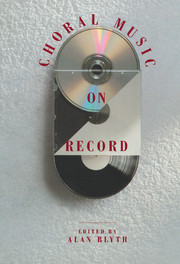Book contents
- Frontmatter
- Contents
- Preface
- Monteverdi: Vespers (1610)
- J.S. Bach: St John Passion
- J.S. Bach: St Matthew Passion
- J.S. Bach: Mass in B Minor
- Handel: Messiah
- Mozart: Requiem Mass
- Haydn: The Creation
- Haydn: The Seasons
- Beethoven: Missa Solemnis
- Mendelssohn: Elijah
- Rossini: Stabat mater Petite messe solennelle
- Berlioz: Grande Messe des Morts Te Deum L'Enfance du Christ
- Verdi: Requiem Mass
- Brahms: A German Requiem
- Fauré: Requiem
- Elgar: The Dream of Gerontius
- Walton: Belshazzar's Feast, Tippett: A Child of Our Time, Britten: War Requiem
- Stravinsky: The Wedding Symphony of Psalms
- Janáček: Glagolitic Mass
- Discographies
- Index
Janáček: Glagolitic Mass
Published online by Cambridge University Press: 02 December 2009
- Frontmatter
- Contents
- Preface
- Monteverdi: Vespers (1610)
- J.S. Bach: St John Passion
- J.S. Bach: St Matthew Passion
- J.S. Bach: Mass in B Minor
- Handel: Messiah
- Mozart: Requiem Mass
- Haydn: The Creation
- Haydn: The Seasons
- Beethoven: Missa Solemnis
- Mendelssohn: Elijah
- Rossini: Stabat mater Petite messe solennelle
- Berlioz: Grande Messe des Morts Te Deum L'Enfance du Christ
- Verdi: Requiem Mass
- Brahms: A German Requiem
- Fauré: Requiem
- Elgar: The Dream of Gerontius
- Walton: Belshazzar's Feast, Tippett: A Child of Our Time, Britten: War Requiem
- Stravinsky: The Wedding Symphony of Psalms
- Janáček: Glagolitic Mass
- Discographies
- Index
Summary
Janáček was entering his seventy-third year when he composed the Mša Glagolskaja in 1926. Long before, he had composed one Mass, now lost, and begun another which he left incomplete. The ‘Glagolitic’ is one of the fruits of his famous Indian summer, warmed by his passionate affection for Kamila Stösslová, thirty-eight years his junior. He had just finished liis Sinfonietta, an instant success, and more music was still to come from his remaining two years: the Second String Quartet, the Říkadla (‘Nursery rhymes’) settings, the Capriccio for one-armed pianist and ensemble, and the opera From the House of the Dead.
By Janáček's advanced standards of quirkiness, the Mass is rather straightforward – wholly idiosyncratic, of course, but nothing like so odd as the Capriccio or the last opera or quartet. There is an obscure quirk in its title: having chosen to set the Mass not in Latin but in an Old Slavonic version from the ninth century, he seems to have got the idea that the word ‘Glagolitic’ applied to that language. In fact it means the script in which it was originally written down, with which of course he had no concern. Certain sections of the Latin text are shortened in this Slavonic Mass; the Sanctus and the Benedictus are run together. To the choral movements, which include all the solo singing as well, Janáček added not only an Introduction but a final Intrada for orchestra, and between the Agnus Dei and the latter a churning Postlude for organ alone.
- Type
- Chapter
- Information
- Choral Music on Record , pp. 258 - 263Publisher: Cambridge University PressPrint publication year: 1991



